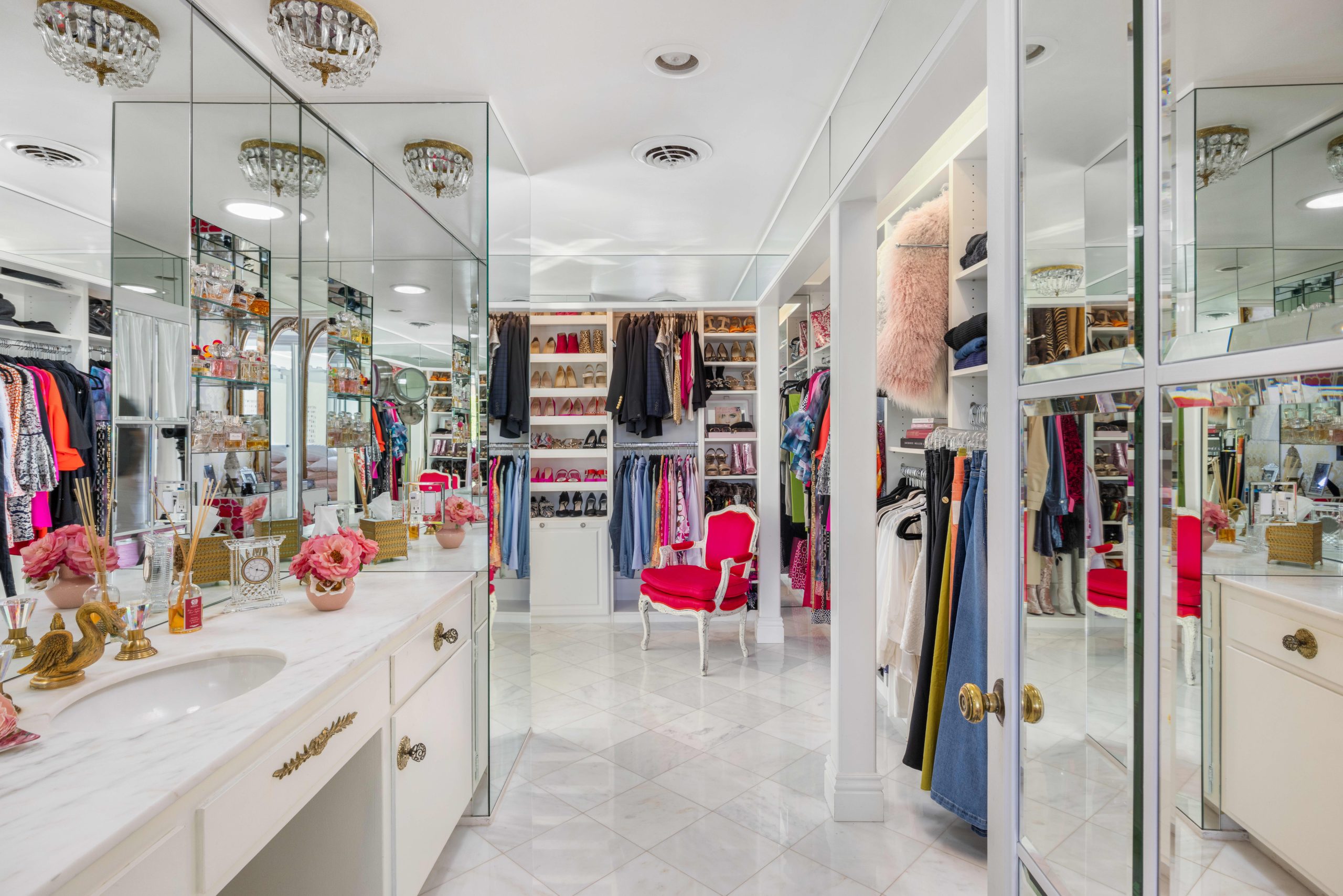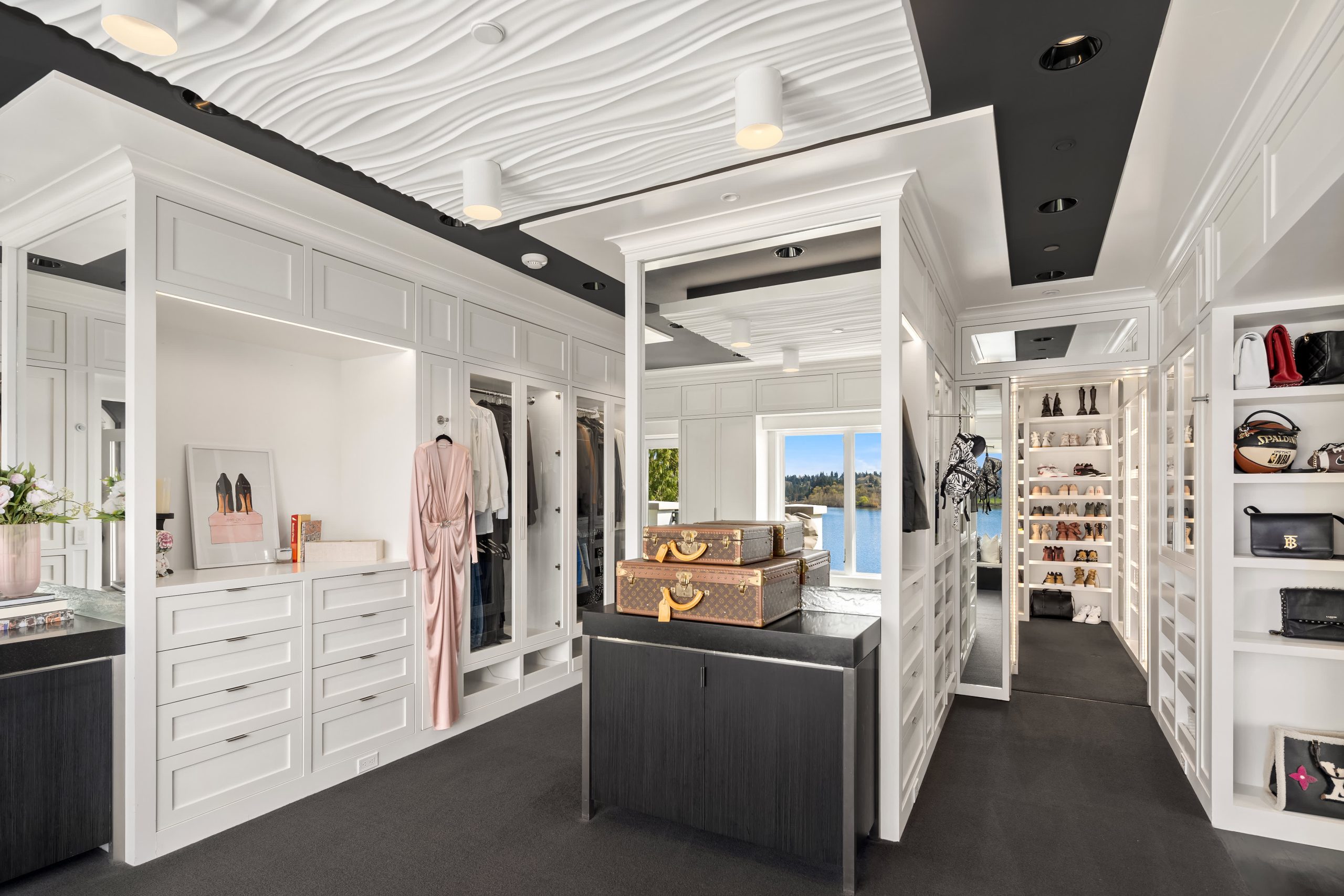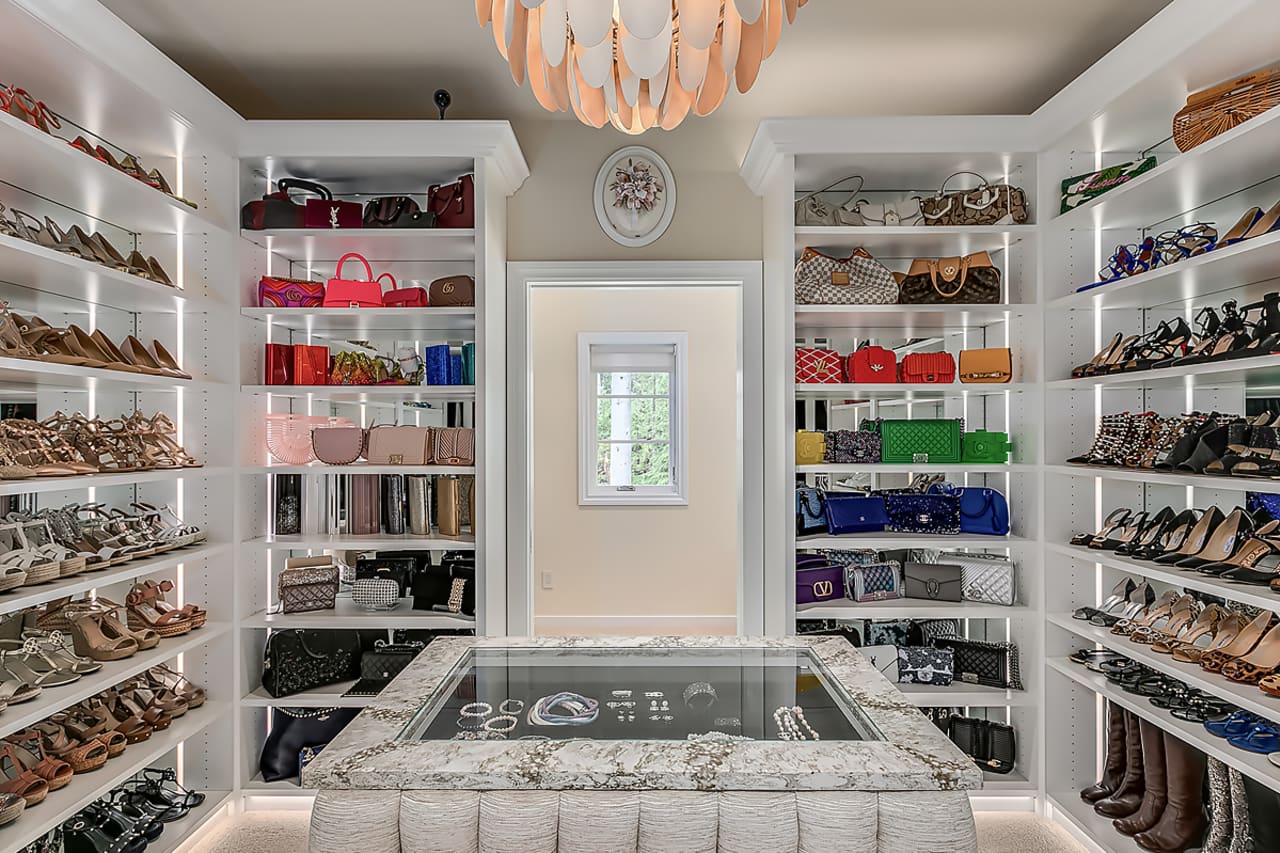Forget the Pool or Even the Living Room—‘Our Closet Time Is Precious’
Some homeowners are taking the coziness and intimacy of the primary suite’s walk-in wardrobe to the next level and transforming it from functional storage into the home’s centrepiece
A room you might not expect comes to mind when home seller Karen Haines reflects on fond memories at her Hollywood Regency-style house in Palm Springs, California: her bedroom closet.
“Forget the great room, swimming pool or hot tub. All the action in the house happens in the closet. It’s where everyone wants to be,” said Haines of the enormous space, which is decked out with white tones, mirrors, marble and gold finishes, and has double sinks with bird-shaped faucets.
Haines and her husband, Chris, are selling the house, designed by acclaimed architect Robert Marx and on the market with Douglas Elliman for $5.2 million. The couple, both entrepreneurs in the music industry, usually keep classic rock ‘n’ roll playing in the closet all day, she said.
“My daughter and I try on clothes in there, and Chris and I drink coffee in the morning and cocktails come evening,” she said.
For most homeowners, closets are merely functional—that is, a place to hold clothes, accessories and other items that they turn to for everyday wear. Some, however, are taking the coziness and intimacy of the primary suite’s walk-in closet to the next level and turning it into the home’s prized space. It’s become a place where couples can connect at the end of a hectic day or a lounge where owners socialise with friends, enjoy a morning coffee, and, yes, even imbibe with cocktails and wine.
Chris Lim, a real estate agent and former president of Christie’s International Real Estate, said that he is witnessing a redefining of the concept of walk-in closets.
“With the inclusion of features like bar sinks, lounge seating, spacious islands and glass displays and expanded vanity areas, walk-in closets now offer a retreat for morning rituals and post-day relaxation,” he said. “They’ve become hubs of activity and connection in multimillion-dollar homes.”

Part of the trend, he said, is the growing number of fashion and social media influencers, who often use their bedroom closets as their offices or filming space.
When it comes to showpiece closets, Brazilian design firm Ornare is a leading name and charges between $30,000 and close to $1 million for its services.
Claudio Faria, the CEO of Ornare Miami, said that when he opened his business in 2007, closets were an afterthought with homeowners investing their money in zhuzhing up public-facing spaces such as kitchens and family rooms. Now, he said, closets are dominating home design—his business has grown 50% annually for the last five years as a result.
“Closets have become more important because, in the way that wealthy people collect cars and art, they’re collecting clothes, and closets are the venues to show them off,” Faria said. They’re also a unique area to use in your home because of their intimacy and become talking points.”
Ana Paula Siebert Justus is a client and tapped Ornare to bring her vision of a glamorous closet to life. Justus, a fashion influencer, and her husband, Roberto Justus, an entrepreneur, own a five-bedroom condominium in Sunny Isles, Florida. The large wardrobe in their bedroom is awash in green hues, wood and leather. Backlighting features throughout, and there are sections for handbags and clothes plus a hat rack and a vanity with a chair.
“I spend a lot of time in my closet shooting content, so it needs to be in photograph-ready shape,” she said. “It has no door, and one of my favorite ways to connect with Roberto is to catch up as I’m getting dressed for the day or evening events. Our closet time is precious.”
Tina Trahan, a philanthropist and art collector, lives in Los Angeles’s Studio City neighbourhood in a 5,100-square-foot home that was the exterior for the home on “The Brady Bunch” TV series. She shared similar sentiments about her closet. She has repurposed one of the bedrooms into the space and has outfitted it with double-height rolling racks, a three-way mirror, a sofa, a Miele coffee machine and a fridge stocked with drinks including White Claws—her beverage of choice.

Trahan said that she frequently entertains girlfriends, and they love heading to her closet to drink tequila and wine and catch up.
“We end up ordering sushi and eating it there. My closet is 100% our favourite place to hang out,” she said.
Other examples of these double-duty flashy closets abound.
Real estate agent Katrina Barrett of Christie’s International Real Estate Walt Danley | Local Luxury is overseeing the marketing and sale of a $40 million home in Paradise Valley, Arizona. The centrepiece of its primary suite is an expansive closet with seating, a steaming area, hidden panels to store valuables and a secret door leading to a sports barn with a pickleball court and golf simulator.
In another example, Susan Archer is selling her home in Issaquah, Washington, near Seattle, for more than $6 million through Windermere Real Estate/Luxury Portfolio International. She described the property’s primary bedroom’s closet as “a haven for creating memorable moments with friends and family.”
The white-painted space has marble and cream walls and features backlighting, a display case that’s common in upscale boutiques, a washer and dryer, a wet bar, an island and seating.
“Many of my girlfriends and I have gathered around the island, their excitement palpable as they admire my collection. With champagne flutes in hand, the atmosphere is lively and carefree,” Archer said. “Beyond the soirées with friends, my closet holds a special place for precious moments with my daughter. As she grows, her interest in fashion blossoms, and my closet becomes a treasure trove of inspiration for her budding style.”
 Copyright 2020, Dow Jones & Company, Inc. All Rights Reserved Worldwide. LEARN MORE
Copyright 2020, Dow Jones & Company, Inc. All Rights Reserved Worldwide. LEARN MORE
This stylish family home combines a classic palette and finishes with a flexible floorplan
Just 55 minutes from Sydney, make this your creative getaway located in the majestic Hawkesbury region.
We’re thinking about productivity at work all wrong, Cal Newport says. But how do we tell the boss that?
You’re oh so busy. You’re on Slack and email and back-to-back Zoom calls , sometimes all at once . Are you actually getting real work done?
Cal Newport doesn’t think so.
“It’s like, wait a second, none of this mattered,” says the Georgetown University computer science professor and crusader for focus in a distracted age.
Newport, 41, says we can accomplish more by shedding the overload. He calls his solution “slow productivity”—and has a book by the same name —a way for high achievers to say yes to fewer things, do them better and even slack off in strategic doses. Top-notch quality is the goal, and frenetic activity the enemy.
This, he told me, is the thing that can save our jobs from AI and layoffs, and even make shareholders happy.
I had questions. Can we really be less is more at work, or have we grown addicted to constantly crossing endless tasks off our to-do lists? What will our bosses think?
After all, so many of us yearn for a burnout cure-all that will preserve our high-achiever status, and this isn’t the first you-can-have-it-all proposition we’ve heard. Champions of the four-day workweek promise we can ditch an entire workday just by working smarter. Remote-work die-hards swear it’s a win for employers and employees. Few dreams are more seductive than bidding goodbye to hustle culture, while still reaping the benefits of said hustle.
Newport acknowledges that saying no to preserve our productivity can be a delicate act. He knows that entrepreneurs have more flexibility, but says those of us who answer to managers can carve this out too. We might even find we have more power and value to our employers.
“You should take that value out for a little bit of a spin,” he suggests. He offers some pointers.
Less is more
The way we work now is a “serious economic drag,” Newport says. Knowledge workers have devolved into a form of productivity that’s more about the vibes—stressed!—than actually making money for the company. Data from Microsoft finds that lots of us spend the equivalent of two workdays a week on meetings and email alone.
One mistake we make, Newport says, is taking on too many projects, then getting bogged down in the administrative overload—talking about the work, coordinating with others—that each requires. Work becomes a string of planning meetings, waiting on someone from another department to give us a go-ahead.
Newport recommends giving priority to a couple projects, then bumping the others to a waiting list in order of importance. Make that list public, say, in a Google doc you share with bosses and colleagues.
“When workloads are obfuscated behind black boxes, it’s just people throwing stuff at each other, it’s very dangerous to say no,” Newport says.
If someone comes to you with more work, have them consider where it should go on your list, Newport says.
When you do say yes, double the estimated timelines you set to complete a project. That’s how long it’ll take to do it well, he says. And try what he calls a “one for you, one for me strategy.” Every time you book an hour-long meeting, block an hour for independent work on your calendar.
Be the one to trust
It’s a foreign and bracing approach for those of us who reflexively say yes to work requests. Newport’s philosophy requires transparency and confidence. Instead of “let me see how fast I can turn that around!”, try, “This request will take six hours. I’ll have that time in three weeks.”
This could be heresy at some companies. The trick is in the delivery, he says. Never make it seem like work tasks are a burden you shouldn’t have to face. Instead, stress that you’re trying to be as effective as you can for the team and the company. Be positive, and deliver on the timelines you promise. You’ll be seen as someone who’s organised and on top of your game.
We think bosses want someone who’s always accessible—fast to respond, fast to jump into action, Newport says. But what bosses really want is to know that a project they hand you will get done.
Bite-size shirking
Quiet quitting permanently is a bad idea, Newport says, but a little bit is good.
Don’t feel guilty, he adds. You’re working under a new, better system. We weren’t meant to work all out , every day, without seasonal shifts and pauses.
Pick a time—say, the month of July—to slow down. Don’t volunteer for extra work. Don’t offer Mondays as a possibility for meetings. Take on an easier project for cover.
He also recommends taking yourself out to a monthly movie during the workday. Say it’s a personal appointment, and enjoy the sense of control and creativity it brings.
You don’t have to nail a manifesto to the wall, he adds, or try to change the whole company culture. Instead, quietly carve out change for yourself.
Coming into your power
The catch: You have to be really good at the part of your job that matters. And you have to get big stuff done. Remember, this is about being a happier high performer, not slacking.
“There’s no hiding,” Newport says.
I suspect this terrifies a lot of people. They’ve gotten good at being always on and typing up yet another meeting agenda. Tackling a major project or goal is often harder, and comes without a guarantee that you’re going to nail it.
Scary or not, real work is becoming imperative. AI is coming for the rote parts of our jobs. Leaders are sussing out the “nonsense” projects and roles in their ranks as they cut jobs, Newport says. No boss wants to be left with a team of people who are aces at responding to emails.
Mastering a valuable skill puts you in control. Newport writes of people who leave corporate America behind and move where they want , working remotely as contractors, charging wild fees for fewer hours of work. The more you shed the work that doesn’t matter, and spend that time getting better at the stuff that does, the more leeway you’ll get.
“The marketplace doesn’t care about your personal interest in slowing down,” Newport writes. “If you want more control over your schedule, you need something to offer in return.”
Figure that puzzle out, and you might just be able to have it all—high achievement, and your sanity.
Consumers are going to gravitate toward applications powered by the buzzy new technology, analyst Michael Wolf predicts
This stylish family home combines a classic palette and finishes with a flexible floorplan























